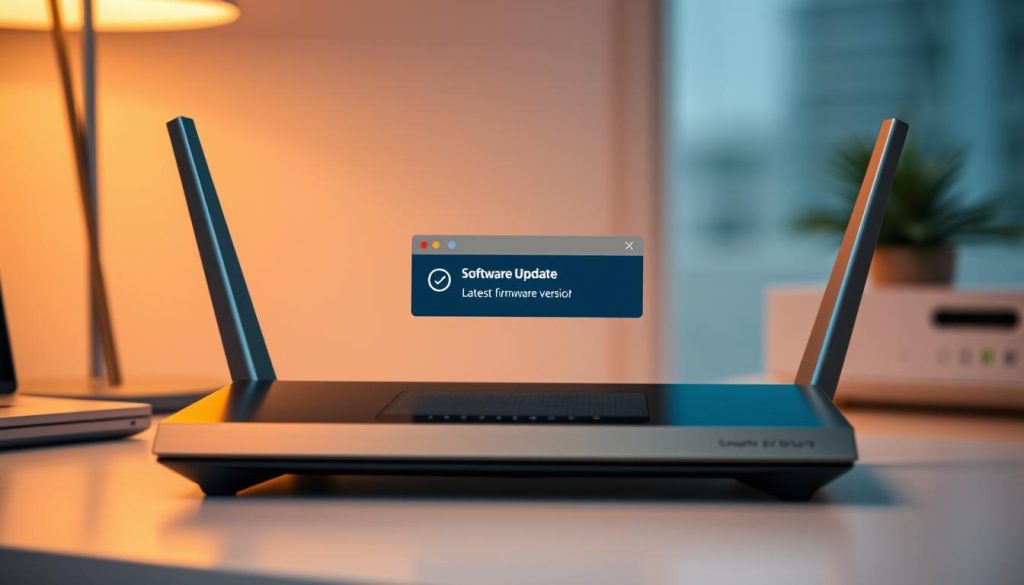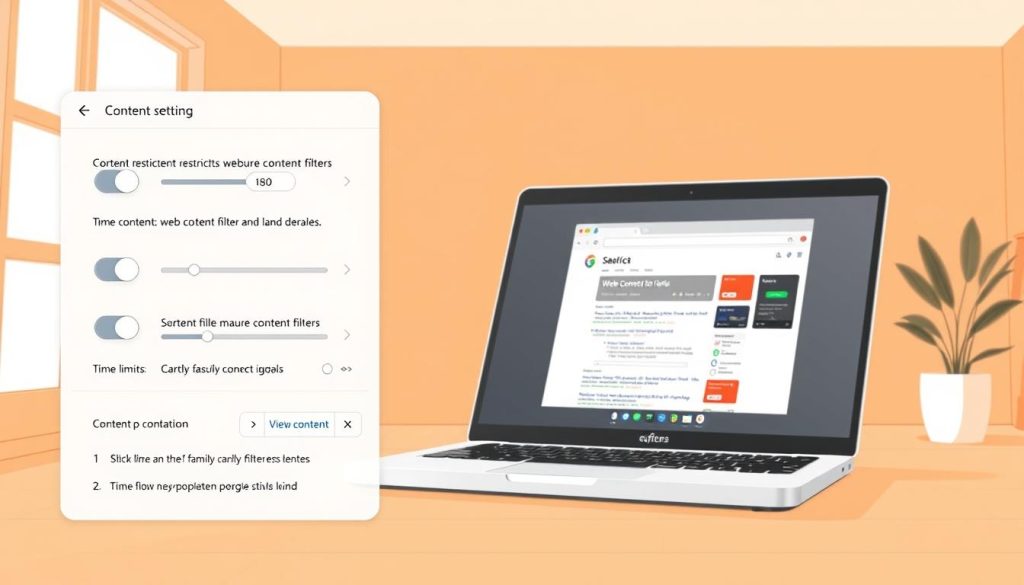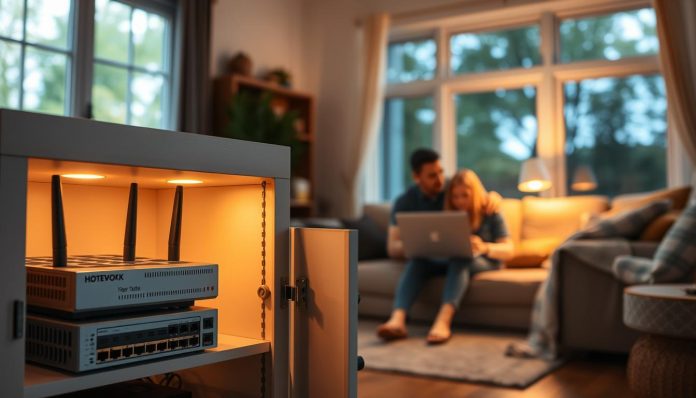Start with a simple checklist: set strong, unique Wi‑Fi passwords, enable WPA3, and keep routers and modems updated monthly. Change default admin names, disable remote management, and enable the router firewall so the whole network gains immediate protection.
Use guest Wi‑Fi to isolate smart TVs, cameras, and visitors from school devices. Add a hardware firewall like HPN Defender to block harmful sites and phishing across the network, and set parental controls, content filters, and reasonable time limits for online study.
Coach kids about suspicious links, pop‑ups, and addictive content algorithms that steal attention from homework. Install reputable antivirus on school laptops, keep every device patched, and avoid auto‑connecting to public hotspots. For safe guidance and tools from your district, see this resource: tools for keeping children safe online.
Key Takeaways
- Secure the router: strong passwords, WPA3, firmware updates, and built‑in firewall.
- Isolate gadgets with guest Wi‑Fi and use a network firewall like HPN Defender.
- Set parental controls, content filters, and screen time limits for better focus.
- Keep devices patched and run reputable antivirus on school laptops.
- Teach kids about suspicious links, pop‑ups, and ads that mimic search results.
- Use a VPN on public Wi‑Fi and forget old networks your devices no longer need.
Why Back-to-School Is the Right Time to Lock Down Your Home Network
A new semester brings heavier device use, making this the ideal time to improve network security.
Your kids will spend more time online for homework, research, and media. That raises the chance of malware, phishing, and distracting sites appearing on the home network.
Small, quick steps at the router level protect every device that connects. Use WPA2 or WPA3 encryption, change default admin credentials, and disable remote management. Keep firmware and router software current so attackers and curious people have fewer openings.
Guest networks isolate visitors and IoT gadgets. On public hotspots, avoid auto‑connecting and use a VPN for encrypted traffic. Check with your ISP — they may push updates, but you should still confirm the latest firmware and service notices.
| Action | Why It Helps | When to Do It |
|---|---|---|
| Enable WPA3/WPA2 | Encrypts traffic on the wireless network | Before school starts |
| Change admin address and creds | Blocks remote takeover attempts | One-time, then document |
| Set up Guest SSID | Isolates TVs and cameras from devices | Weekly check when adding gadgets |
| Update firmware/software | Closes known vulnerabilities | Monthly or enable auto updates |
- Schedule these changes before classes begin to avoid disruptions.
- Document the router admin address, chosen options, and the date you last updated settings.
Strong Wi‑Fi Credentials and Smart SSID Choices
Small edits in router names and passphrases make a big difference for school devices on the network.
Create a unique, long password for each Wi‑Fi network. Use at least 14–20 random characters and never reuse passwords that protect other accounts. This reduces the chance that stolen credentials expose family data and traffic.
Pick a neutral SSID that does not reveal your last name or street address. Avoid SSIDs like “SmithFamily_1234 Maple Ave.” A name such as BlueSkies_5G is easier to manage and harder to link to your home.
Change default admin credentials on the router administration page right away. Defaults like “admin/password” are well known and let attackers change settings or freeze devices.
- Unique Wi‑Fi password per network (14–20 random chars).
- Neutral SSID—no family name, school, or address.
- Update the router admin username and password on the admin page.
- Keep separate passphrases for primary and guest networks.
- Store both Wi‑Fi and admin credentials in a password manager.
- Reconnect devices methodically and check for connection issues.
Quick reference
| Action | Why it helps | When to do it |
|---|---|---|
| Set strong Wi‑Fi password | Protects data and traffic from eavesdropping | Immediately, then rotate periodically |
| Rename SSID to neutral name | Makes network harder to associate with your home address | One-time, update when adding devices |
| Change default admin login | Prevents easy takeover of router settings | Right after initial setup |
Turn On Modern Encryption: WPA3 First, WPA2 If Needed
Set your router to the latest encryption standard so data moving through your home is unreadable to outsiders.
Where to find the option: open the router administration page, go to the Wi‑Fi or Security settings, and look for WPA3 Personal. If a mixed device pool causes connection issues, choose WPA2 Personal as a fallback.
If neither WPA3 nor WPA2 appear, update the router firmware or software and check again. Modern encryption hides traffic on the network so nearby snoops cannot read pages, logins, or other data.
“WEP and WPA are outdated and not secure — replace routers that only offer those modes.”
- Confirm every device can join the chosen mode; older device models may require WPA2.
- After switching encryption, re‑save the SSID and passphrase so devices reauthenticate.
- If the router only offers WEP/WPA, you need change router hardware to keep the network safe at home.
- Test school portals and video calls to verify performance after the change.
Make a quick note of the date you enabled WPA3 or WPA2 so you can verify settings after future updates.
Keep Routers and Modems Updated With the Latest Firmware
An up-to-date router closes vulnerabilities and can add useful new features for a smoother school year. Firmware and router software deliver security fixes that stop attackers and improve stability for video calls and school apps.

Enable automatic updates or set a monthly reminder
Turn on automatic firmware or software updates if the feature exists. If not, add a recurring calendar reminder to check once a month.
Register devices with the manufacturer or ISP
Register your router and modem so customers receive email alerts from the manufacturer or service provider. ISP-supplied equipment may get pushed updates, but you should still log into the administration page and confirm the installed release.
- Run a manual check in the router admin and install the latest stable release.
- Note the firmware version and the date in a simple change log.
- After updates, verify SSIDs broadcast and all connected devices rejoin the home network.
- Read release notes for security fixes that harden your network; plan a replacement if updates stop arriving for an old model.
Harden Your Router: Disable Remote Management and Enable the Firewall
Shrinking the router’s exposed features stops easy attacks and keeps family devices safer.
Quick steps will cut the chance that strangers reach the admin page or push unwanted changes.
- Open the administration page and disable remote management so the router cannot be reached from the internet.
- Turn off WPS and UPnP. Those convenience features let devices join or open ports without clear controls.
- Enable the built‑in firewall to block unsolicited data and reduce incoming threats across the network.
After you make changes, log out of the admin session and reboot the router. Check the guest and primary SSID. Review port‑forward rules and remove any entries you do not recognize.
Consider limiting admin access to wired connections and replace any default credentials you still use. Revisit these settings quarterly so firmware updates do not reenable risky features.
| Action | Where to find it | Benefit for the home |
|---|---|---|
| Disable remote management | Admin/Management page | Blocks external admin access |
| Turn off WPS & UPnP | Wireless or Advanced settings | Reduces automatic openings and weak joins |
| Enable built‑in firewall | Security or Firewall tab | Stops unsolicited traffic to devices |
| Log out and reboot | After saving settings | Prevents browser session tampering |
Segment Your Home With a Guest Network for Visitors and Smart Devices
A guest network acts like a digital buffer between casual users and the devices you rely on for school. Set up the router’s guest feature and give it a different SSID and passphrase so visitors and non‑essential gadgets stay separate.
Move TVs, cameras, smart speakers, and other connected devices onto the guest network. If one of those devices gets compromised, it will have a much harder time reaching student laptops, phones, and shared files.
- Enable the guest network feature and create a unique SSID and password for visitors and guest devices.
- Place smart TVs, thermostats, cameras, and tablets on the guest SSID so their traffic stays isolated from primary devices.
- Use a different passphrase so primary network credentials do not spread.
- Many routers isolate guest clients from each other, which reduces lateral movement if one device is breached.
- Periodically review the guest client list and remove devices that no longer need access.
| Action | Benefit | When |
|---|---|---|
| Create guest SSID | Keeps student devices and data private | Once, when setting up router |
| Place IoT devices on guest network | Limits access if a gadget is compromised | When adding new devices |
| Use separate password | Prevents wide sharing of primary credentials | Every time you invite guests |
| Review client list | Removes forgotten devices and reduces risk | Monthly or quarterly |
Block Harmful Content at the Source With a Hardware Firewall
Filtering traffic at the source lets you cut distractions and threats for every device on the home Wi‑Fi. A hardware firewall like HPN Defender stands between the router and the modem and filters DNS and web requests before pages load.
Use network‑level filtering so phishing sites, malware domains, and adult content are stopped across the entire network. This saves effort because you do not need client software on each device.
Use solutions like HPN Defender to stop phishing sites, malware, and adult content network‑wide
Category filters reduce age‑inappropriate content and cut pop‑ups and ad distractions during homework hours. Many appliances use cloud intelligence and automatic updates so the service improves without manual checks.
Reduce risk and distractions by filtering traffic before it ever reaches a child’s device
Pair the hardware firewall with the router’s built‑in firewall and modern encryption for layered security. Set per‑device or per‑profile rules so adults and older kids keep broader access while younger students stay limited.
- Add a hardware firewall such as HPN Defender to filter harmful content and phishing site requests for every user on the network.
- Network‑level filtering blocks risky traffic before it reaches browsers or apps, protecting all devices with no per‑device setup.
- Configure safe search and anti‑malware lists, then test by visiting harmless test pages to confirm the block is active.
| Feature | Benefit | When to apply |
|---|---|---|
| DNS and web filtering | Stops phishing, malware, adult content at the network edge | During initial setup |
| Category filters & schedules | Reduces distractions during homework and bedtime | Set weekly or for school nights |
| Cloud threat updates | Keeps blocking lists current with minimal effort | Enable automatic updates |
| Per‑device rules & allow‑list | Tailors access for age groups and trusted sites | After testing and review |
Set Up Parental Controls, Content Filters, and Time Limits
Set clear online boundaries so study time stays focused and sleep schedules stay regular.

Use router filters or a managed service
Turn on router‑level filtering or subscribe to a managed service that blocks adult, malware, and phishing categories across the network. This reduces hits to risky sites before they reach devices.
Apply device controls for school laptops and tablets
Enable device‑level parental controls to limit apps, social media, and streaming media by age. Change any default admin passwords and log out of the admin console so kids cannot alter settings.
Create schedules for school nights and sleep
Make schedules that pause browsing and streaming late at night. Allow educational sites during homework hours while restricting high‑distraction platforms.
“Combine network filters with device tools for layered safety and fewer interruptions during study time.”
- Enable safe search and YouTube Restricted Mode.
- Review weekly reports for spikes in usage or attempts to reach blocked content.
- Balance limits with access to needed educational data and sites.
| Action | Benefit | When |
|---|---|---|
| Router content filter or managed service | Blocks adult and malware categories at the network edge | At setup, then review monthly |
| Device‑level controls and app limits | Tailors access by age and prevents social media overuse | Before school, update each grading period |
| School‑night schedules | Improves sleep and homework focus | Set weekly for school nights |
Teach Safe Clicking: Spotting Phishing, Sponsored Results, and Pop‑Ups
Teach kids to pause before clicking and to check a link’s address when something looks urgent or odd.
Sponsored search results are ads. Explain that ads can lead to look‑alike sites that steal logins or ask for downloads. Practice hovering over links so children see the real URL and spot misspellings before they click.
Coach children to avoid suspicious links and ads
Show examples of fake pages and explain quick checks: read the domain, ignore urgent language, and never install unknown browser extensions.
Discuss addictive algorithms and reporting tools
Talk about content that keeps pulling attention and teach ways to mute, block, and report creators on social media and media platforms.
Public Wi‑Fi risk includes fake SSIDs that mimic airports or cafes. Remind kids never to auto‑connect and that a VPN can encrypt traffic when they are away from the home network.
- Pause and verify: ask a parent if a message feels urgent or too good.
- Close pop‑ups safely and never enter credentials on a suspicious site.
- Celebrate good choices so safe clicking becomes normal at home.
| Action | Why it helps | When |
|---|---|---|
| Hover to preview URLs | Reveals real domain before clicking | Every time you see a link |
| Report and block creators | Reduces exposure to harmful content | When you see problematic posts |
| Use a VPN on public Wi‑Fi | Encrypts traffic and lowers risk | Whenever off the home network |
How To Protect Your Internet When Devices Leave Home
When students leave home, simple habits can keep their connections safer on public networks.
Install reputable antivirus on every school device and enable automatic updates. Good antivirus stops common malware and flags risky downloads before they run.
Keep operating systems, browsers, and apps fully patched. Patches close holes attackers use when a laptop or tablet is off the home network.
Use a VPN on public Wi‑Fi
A virtual private network creates an encrypted tunnel that hides what you browse from nearby snoops. When you use vpn on a cafe or library connection, data is much harder to intercept.
Disable “Connect automatically” and forget old SSIDs you no longer control. Always verify the exact wireless network name with staff before joining public Wi‑Fi.
- Prefer cellular data or a phone hotspot for critical school work when Wi‑Fi looks untrusted.
- Turn off Wi‑Fi and Bluetooth when not in use to save battery and reduce unwanted pairings.
- Log out of sensitive accounts after use and avoid banking or changing passwords on shared networks.
“A VPN and up‑to‑date software make a strong pair for safe on‑the‑go connections.”
Conclusion
Close the loop on security by making the network the first line of defense for student devices.
Use WPA3 or WPA2, change the default username password and pick a neutral SSID so your address stays private. Disable remote management, WPS, and UPnP, then enable the router firewall and keep firmware current.
Segment guests and smart gadgets with a guest Wi‑Fi and forget old networks that no longer serve you. Keep device hygiene with patches and antivirus, and use a VPN on public Wi‑Fi for added data safety.
If your router cannot run modern encryption, you need change router hardware. For real peace of mind, invest in a hardware firewall so whole‑home protection works quietly in the background.

